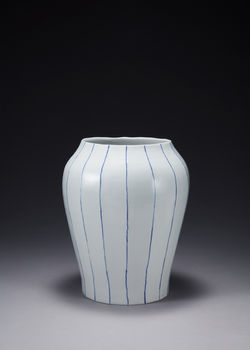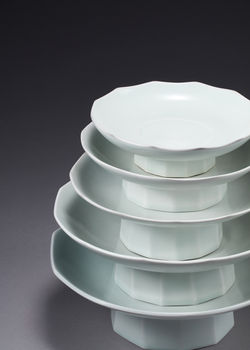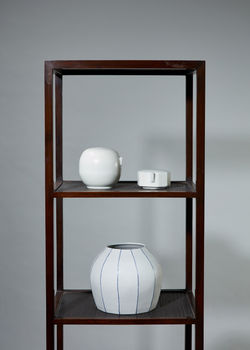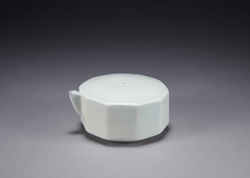Korean Craft: Yesterday and Today 한국의 공예: 어제와 오늘
2019년 5월 3일(금)~ 6월 21일(금)
미국 워싱턴 한국문화원
참여작가 : 김설, 박숙희, 조예령, 최지만, 프로젝트레벨라인
현대 백자 : 최지만
백자는 한국의 조선시대 초기(15세기) 왕실 및 관청용 도자기를 전담하던 관요의 설치와 함께 급격하게 발전하였다. 고려가 청자의 시대였다면 조선은 백자의 시대라고 할 수 있는데 눈부신 도자기 발전의 배경에는 백자에 대한 동경, 관요의 전문적인 설치 운영, 그리고 뛰어난 제작기술이 있었다. 경기도 광주에 설치된 관요에서 조선을 대표하는 백자들이 다수 제작되었으며 이곳에서는 용도에 맞춰 다양한 종류의 도자기들이 만들어졌는데 제작 시기에 따라 형태와 특징을 달리하는 그릇들이 나타난다. 이후 초벌구이 한 백자 위에 코발트 안료로 그림을 그린 백자청화가 제작되는데 이는 하얀 백자의 바탕에 회화성을 강조한 것으로 당시의 화풍이 반영되었다.
대표적인 한국 현대 도예 작가인 최지만은 최근 백자와 백자청화 작업을 주로 하고 있다. 그의 작업실은 오래전부터 백자가 만들어지던 경기도 광주에 위치하고 있다. 그 곳에서 최지만의 작업은 조선시대의 도자기를 재현하는데 목적을 두지 않고 있다. 그는 예술을 매개로 삶과 우주의 본질에 다가가고자 하여 도자를 제작하는 것이 도 道를 실현하는 과정이라는 것임에 큰 의미를 둔다.
흙을 치대고 외형을 만들어 가는 과정을 통해서 도예가의 인품 人品과 인생 人生이 드러난다. 도자기를 만들고 굽는 과정에서 무수히 많은 실패를 거듭하게 됨으로 인내심과 관조 觀照하려는 마음가짐이 필요하다.
백자는 화려함과 정교함, 웅장함과는 거리가 멀다. 투명한 듯 밝고 흰 자기는 흰 옷을 입은 도공의 자세처럼 돋보이지 않으나 그 자체로 존재감이 있다. 작가의 마음과 작품이 갖춰야 할 기본적인 바탕에 충실한 도자기가 바로 백자인 것이다.
이번 전시에는 사발, 합盒, 원통, 연적 硯滴, 제기 祭器 등 조선시대 백자의 미감과 연결되는 작품들이 출품되었다. 오랜 시간 동안 변해가는 사회 안에서도 변하지 않고 기본이 되는 형태의 백자들은 방안에 자연과 우주를 들여놓고 자 했던 선비들의 절제된 미감과 품격을 보여주는 것이다.
한국의 목가구와 어우러지는 색과 형태의 대비로 전시된 최지만의 도자에는 희고 푸른 한국의 아름다운 정서가 깊이 녹아들어 있다.
- 전시 서문중-
Modern White Porcelain by Choi Ji-man
Baekja, or white porcelain began to see rapid development following the establishment of royal kilns to produce porcelains exclusively for the royal palaces and government offices in the 15th century, during the early part of the Joseon Dynasty. While the Goryeo Dynasty could be described as the age of cheongja, or celadon, the Joseon Dynasty was that of baekja, or white porcelain. The exceptional development of baekja can be attributed to people’s yearning for white porcelain, the systematic establishment and operation of the royal kilns, and the development of superior porcelain-making skills. Some of the finest Joseon baekja were produced at the royal kilns in Gwangju, Gyeonggi Province, where various porcelains were manufactured, varying in forms and characteristics according to their intended use and production period. In the latter part of the Joseon Dynasty, blue-and-white porcelain began to be produced using cobalt blue pigment to paint images on the surfaces of biscuit-fired white porcelain. The production process reflects the painting style of the late Joseon period, which emphasizes pictorial elements against white porcelain backgrounds.
Choi Jiman, one of Korea’s leading contemporary ceramic artist, has recently turned his focus to white porcelain and blue-and-white porcelain. His studio is located in Gwangju, where white porcelain has been produced for hundreds of years. But Choi does not aim to simply reproduce the pottery of Joseon. Rather, for him pottery making is a meaningful process of realizing the truth while striving toward the essence of life and the universe through the medium of art.
In the process of kneading and molding clay into form, the potter’s personality and life are revealed. Facing countless failures in the process of making and firing pottery, the potter is required to practice patience and contemplation.
Joseon Dynasty white porcelain has little to do with flamboyance, sophistication or magnificence. Though bright, almost transparent, white pottery may not attract our attention in the same way as a potter working on it in white clothing, it does have its own distinct presence. Baekja is the result of the potter’s spirit and work that are fully dedicated to the fundamentals.
This exhibition displays artworks reflecting the aesthetic sense of Joseon Dynasty white porcelain in particular, including sabal (bowls), hap (coverd bowls), wongtong (cylindrical containers), yeonjeok (water droppers) and jegi (utensils for ancestral rites). Even in the ever-changing stream of a society, baekja has retained its basic shape and reflects the restrained aesthetic sense and dignity of the Joseon sadaebu who wished to place nature and the universe inside the room.
It also presents Choi’s pottery, which blends harmoniously with the colors of traditional Korean wooden furniture while contrasting with the latter’s form. Deeply embedded in his artwork are beautiful Korean sentiments in white and blue.
 |  |  |
|---|---|---|
 |  |  |
 |  |  |
 |  |  |
 |  |  |
 |  |  |
 |  |  |
 |  |  |



